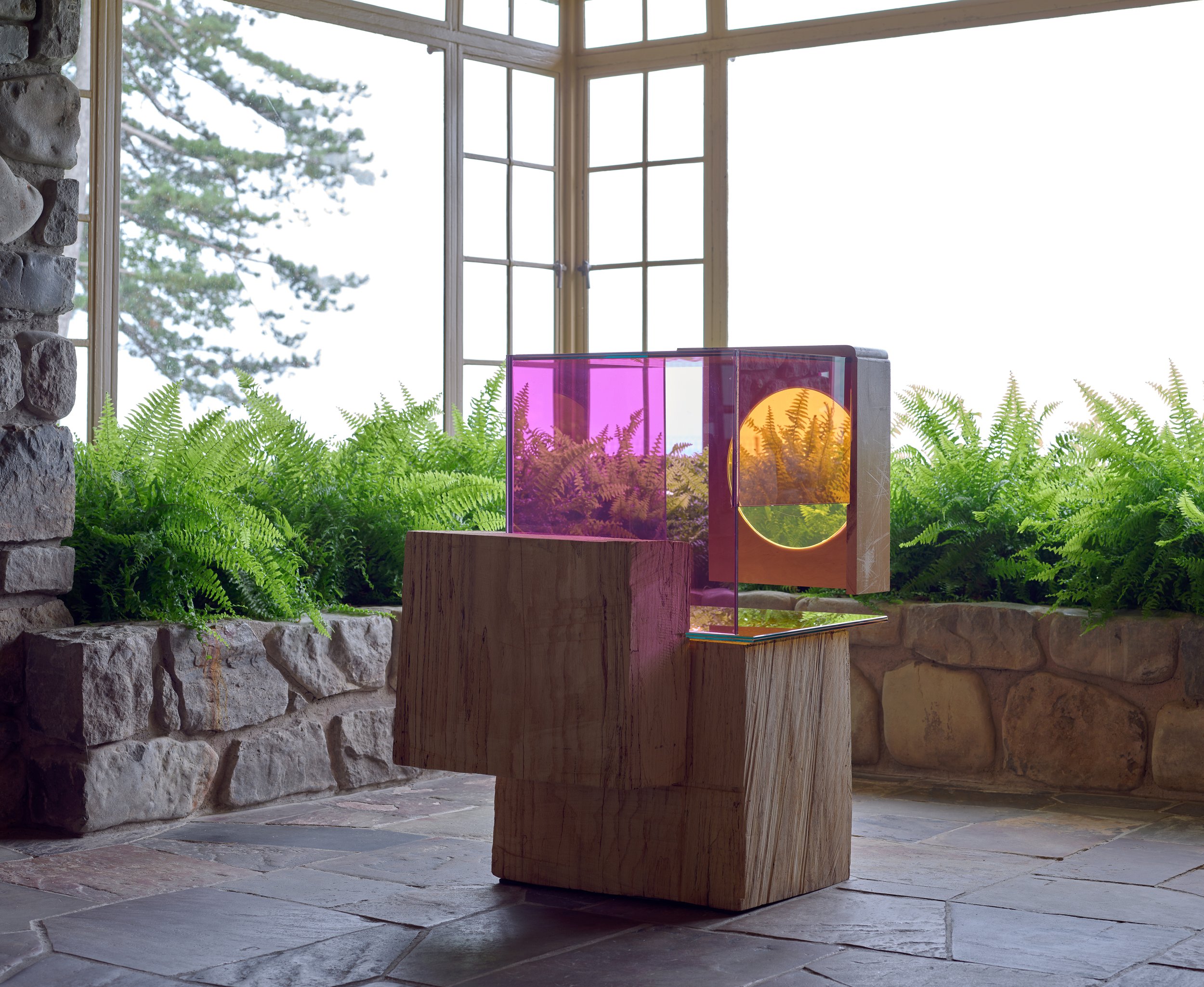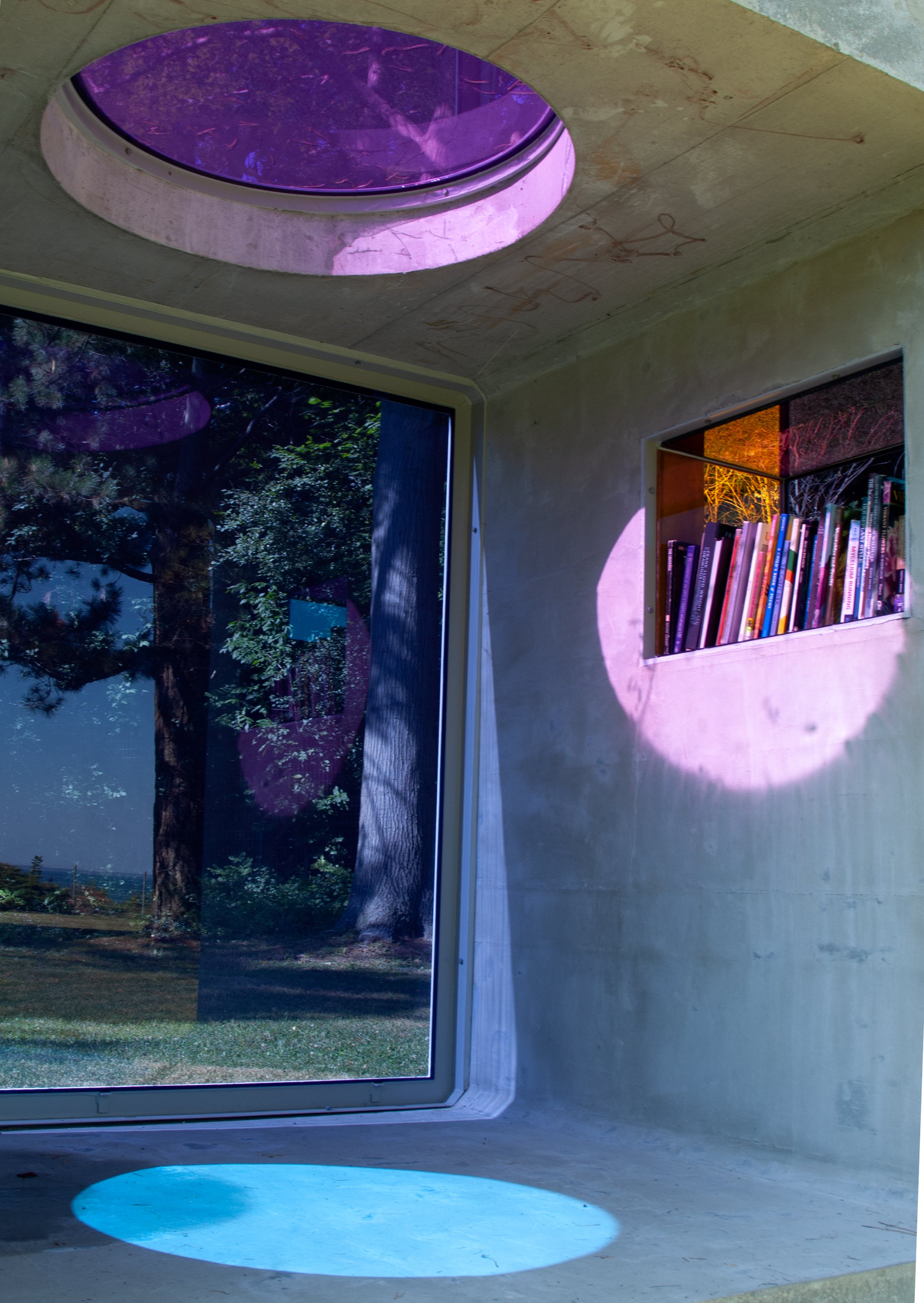Sarah Braman: Finding Room
Buffalo AKG Art Museum & Frank Lloyd Wright’s Graycliff
Sarah Braman, Friend, 2020, installation view, Frank Lloyd Wright's Graycliff. Photo: Brenda Bieger for Buffalo AKG Art Museum
Built between 1926 and 1931, Frank Lloyd Wright’s Graycliff is unquestionably one of the architectural jewels of Western New York. Originally intended as a summer retreat, Graycliff is a long, two-story house with a terra-cotta–colored facade, red pitched roofs, tidy gardens, a chauffeur’s residence, and breathtaking views of Lake Erie. On a clear day, such as the one this writer had the chance to experience, you can see Canadian shores across the wind-stirred surface of the lake.
The property was the second home Wright designed for the family of Darwin and Isabelle Martin, after the eponymous Marin House in Buffalo. It is worth noting that Isabelle, who was plagued by poor eyesight for the length of her life, was the client of record for the project, playing a significant role in crafting Graycliff while also curbing the auteur instincts of Wright. The result is a home flooded with sunlight even on gray afternoons, with airy rooms that balance Wright’s committed reverence for nature, craftsmanship, and simplicity with the practicalities of living.
A series of owners following the Martin’s deaths in the 1950s removed or altered the home’s original features, including flooring, windows, and furnishings. New buildings were constructed, walls were painted, and the home itself fell into structural disrepair. These years of neglect have been almost entirely wiped away through the stewardship of the Graycliff Conservancy, which is committed to not only preserving the Graycliff campus but also making it accessible to thousands of visitors annually. Today its century-old spirit is invigorated by the exhibition Sarah Braman: Finding Room, a collaboration with the Buffalo AKG Art Museum curated by Assistant Curator Andrea Alvarez and Public Art Project Coordinator Zack Boehler.
Wright’s hallmark style influenced generations of architects, but what is most invigorating about Graycliff today is to see this salvaged masterwork in direct contact with contemporary art. Sarah Braman: Finding Room offers an enjoyably iconoclastic conversation between Braman’s sculpture and Wright’s architecture, which find connection through materials such as concrete, wood, stone, and glass. This exhibition is also the very first time that viewers can experience Braman’s indoor and outdoor sculptures together, and reflect on their dialogue.
In their respective practices, Wright and Braman explore the relationship of nature and found elements to human-made objects, drawing attention to lived experience with deceptively simple formal gestures. The interaction between natural and human-made materials and, perhaps especially, the dialogue between light and glass are springboards for both artists.
Sarah Braman, Sit, 2022, installation view, Frank Lloyd Wright's Graycliff. Photo: Brenda Bieger for Buffalo AKG Art Museum
The docent-led tour of the exhibition begins with Braman’s large-scale sculptural interventions outside of the mansion. The first of these is Sit (2022), a smooth concrete ring inlaid with a circle of purple glass and a circle of blue glass, and with one horizontal rectangle and one vertical rectangle cut away from the form. Its shape evokes culverts normally hidden beneath roads and railroads, albeit one turned on its side. Through these interventions Braman renders the given functionality of the culvert moot, and the work becomes a staging ground for views of the surrounding campus’s grounds and architecture framed through its glass and cut-outs. Viewers activate the piece both within and outside. The horizontally cut frame invites guests to do just as the title suggests — sit — and commune in the space between Braman’s sculpture and the Martin’s mansion. The artwork’s colored glass reflects the viewer while superimposing jewel tones on trees, grasses, and architecture beyond. This synthesis of light, color, and experiential viewing demarcates our understanding of how Braman’s sculptures welcome interaction, regardless of their scale.
The second of Braman’s two outdoor sculptures, Stay (2022), sits at the southwest corner of the Graycliff property, mere feet away from the mansion and within view of the Lake Erie Bluffs’ 65-foot drop. If Braman constructed Sit to frame the Graycliff mansion and highlight the act of looking, Stay encourages lingering and investigation. Like Sit, Stay is also inlaid with one blue circle of glass and one purple circle of glass, but here a pane of blue glass seals off one side of this concrete cube while a vitrine-cum-bookshelf punches through an adjoining wall of the structure. Books in shades of blue, purple, and yellow selected by the artist herself fill its shelves; a couple personal favorites of the writer include The New Yorker’s Rejection Collection and Frank Lloyd Wright Drawings. One is implicitly invited to again do as the work entreats: stay. Long looking and exegesis of this work within the work itself are encouraged; thankfully the structure partially buffets the winds that howl off of the lake. The titles of Sit and Stay act as stand-ins for invitations, or the formal conditions defining your visit to a home. Here we are offered books and respite before continuing into the Graycliff mansion.
Sarah Braman, Stay, 2022, installation view, Frank Lloyd Wright's Graycliff. Photo: Brenda Bieger for Buffalo AKG Art Museum
When entering the home guests are asked to cover their shoes with baby-blue hospital booties. This is ostensibly to prevent dirt from passing deeper into the house and lends a slightly clinical feeling to the proceedings. Passing from the honey-hued wooden entryway into the Martin’s sunroom reveals the first of Braman’s indoor sculptures. Stay, peering into the windows from the lawn beyond, underscores the shift in scale. Reading (2020) is the elegiac thesis of Braman’s exhibition, the center on which its narrative begins to turn. Delicately stacked on one of her grandmother’s gold spindle-legged nesting tables is a cube of layered, colored glass. In this smaller form, Braman’s blues, purples, and yellows come into closer harmony along with rough-hewn hunks of wood that seem to both cradle and brace the stacked cube. The piece also lays bare the artist’s investment in formal aspects such as color theory; even on a cloudy day the panes of glass latch onto the light flooding through Wright’s rectilinear, minimal window treatments. The light mixes colors from different panes of adjoining glass. These become hazy within the heart of the artwork and are dashed onto the restored linoleum flooring of the sunroom.
Calling back to Stay, Reading nests a single book in a cut from one of the two wooden braces. Here the offering is The Endangered Ones, which in this context leads the viewer to consider what around them might be endangered: Is this Braman speaking about nature? The once-endangered Graycliff campus? Or are we — the viewers and visitors to this home — the endangered ones? Viewing Braman’s work through the art historical legacies of Color Field painting and Minimalist sculpture — as the artist and curators make a successful case for in the exhibition text — might lead one to discontinue such interpersonal guesswork. But through small details such as the nesting table, books, stickers, painted wood, and trompe l’oeil effects, these domestic sculptures invite interpretations of interiority and inner space beyond the sheen of delicately stacked glass and external references to historical painting.
It is also worth noting that the house never plays second fiddle throughout this exhibition. It is the context of this home — the interplay between its polished wood floors and taupe walls and the materials of Braman’s domestic objects turned sculpture — that enables the latter emotive purchase.
Installation view of living room, Frank Lloyd Wright's Graycliff. Photo: Brenda Bieger for Buffalo AKG Art Museum
A show-stopping trio of sculptures that populate the Graycliff living room at first give the shrugged-off energy of a rummage sale. These works — Massachusetts (2017), Her Desk (2019), and Paula (2018) — appear as little more than stacked objects: a chair here, a desk there, and a mass market prefabricated door. Upon closer looking, however, the objects begin to mutate around their own inertness. Intervening hunks of wood transform these sculptures and become the canvas for balancing acts of found objects and glass elements. The woods of Massachusetts and Paula, like Reading before it, are geomorphic and give the impression of having been discarded or passed over much like the found objects the artist deploys. Taken as a triad, they begin to flesh out Braman’s interest in the interplay between sensory experience and emotional resonance as distilled through glass, wood, and object.
Dazzling even on a gray day, Braman’s Paula (2018) consists of a blue glass cube perched within a V-shaped niche cut into a hunk of wood that rests on a common-looking dining room chair. The wood and glass take the place of a sitter, effectively denying the chair’s use: this seat is taken. Staged in front of a bay of windows and an Arts and Crafts–era credenza, the spindles of Braman’s chair resume conversation with Wright’s ghost. It is through this dialogue that Wright’s design elements and the gardens beyond are painted sapphire blue, intervening dramatically in the otherwise muted palette of the house and grounds beyond.
Through the sensory experience of the works present on this floor, the viewer is tasked with making sense of Braman’s investment in quotidian domestic materials as the base of her sculptural practice. To follow the metaphor of the chair in Paula, we must first examine what Joan Didion describes as the shrine-building impulse. In Didion’s 2005 book, The Year of Magical Thinking, she grapples with grief following the sudden death of her husband and fellow writer John Gregory Dunne, emphasizing a feeling of dislocation and absence in her loss. Her grief is transmuted through ritual as well as the passing of time. Swathes of Didion’s home remain unchanged in the year following her husband’s death, and her grief rears its head when confronted with Dunne’s things, which she cannot or will not part with. A stack of books, for example, floods Didion with her own memories but also speculative imagining of how Dunne understood these objects he has since left behind. Braman’s work deftly articulates this dislocation from the corporeal, both asking us to make sense of the physical sculpture and holding space for us to introduce our own narratives of domestic inheritance.
Sarah Braman, Your Room, 2017, installation view, Frank Lloyd Wright's Graycliff. Photo: Brenda Bieger for Buffalo AKG Art Museum
Braman’s sculpture also populates the kitchen and second floor of the Graycliff mansion, with works tucked into tidy rooms with inescapable views of the outdoors that again and again offer moments of quiet contemplation. As a tour group we were asked to parse out the connections between the sculpture and the imagined lives of the Martin family. We returned to Isabelle’s poor eyesight, the adjoining room for her companion who assisted her, and the daily life of those who lived here. Marinating in our fiction the tour moved from bedroom to bedroom and back out into the garden to disperse, but not before examining the artist’s earliest sculpture in the exhibition, Your Room (2017), which one of my tour’s cohort jokingly referred to as “a bit of a Frankenstein.” Like Reading down in the sunroom, Your Room is another sculpture featuring glass panes stacked into a rough cube atop another gold-legged table. Hand-painted wooden corners at top and base conjoin the glass — raspberry, purple, and orange this time. What is most striking, however, is the uppermost face of the sculpture, which bears a swath of patterned cloth. One thinks of towels, doilies, wallpaper, or frontispieces of bound books, and it doesn’t feel like a reach to imagine the artist considering these touchstones as well. These domestic materials of construction and comfort are bound and unbound by the artist’s hand, suggesting an emptied vitrine. As empty as they may appear, however, they are symbolically dense.
While these sculptures plumb the emotive weight that crystallizes around objects dispossessed, most resonant is their one-to-one correlation to touchstones in our own lives. It is our relationship to mourning and grief, meanwhile, that constructs monuments from ecosystems of banality; dish towels become relics, and, in the case of Didion’s recent estate auction, paper clips are sold for thousands of dollars. We build our connection to the past through the things left behind. In death and dislocation otherwise-banal objects take on a semi-religious reverence, fetishized and mutated by memory. The goal of Braman’s artwork is to make visible these crystalized mutations that underpin our relationship to one another and our relationship to the material world.
by Dana Murray Tyrrell
Dana Murray Tyrrell is an artist and curator from Niagara Falls, New York. His artwork has been exhibited widely, including credits with the Albright-Knox Art Gallery, the Burchfield Penney Art Center, the Castellani Art Museum, and the University at Buffalo, among others. His most recent solo exhibition, FLOATER, was at Kingfish Gallery (Buffalo, NY). Published writing has appeared in Two Coats of Paint, Cornelia Magazine, Buffalo Rising, and Peach Mag.
Sarah Braman: Finding Room is on view at Frank Lloyd Wright’s Graycliff until March 19, 2023. Please note: This exhibition is accessible only during guided tours. Art Tours are currently offered on Saturdays at 2:30 pm, with free Art Tours on the first Saturday of the month at 11:30 am and 2:30 pm. Advanced registration required. For questions, please contact Graycliff staff at 716.947.9217. Buffalo AKG members must present their membership card upon arrival.






